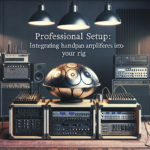<!DOCTYPE html>
<html lang="en">
<head>
<meta charset="UTF-8">
<meta name="viewport" content="width=device=device-width, initial-scale=1.0">
<title>Handpan Technique</title>
<style>
body {
font-family: Arial, sans-serif;
line-height: 1.6;
margin: 20px;
}
h2, h3 {
color: #333;
}
p {
color: #666;
}
ul {
list-style-type: square;
}
</style>
</head>
<body>
<h2>Introduction</h2>
<p>The handpan, a captivating musical instrument, has mesmerized audiences and musicians alike since its invention in the early 2000s. Known for its ethereal sound and unique, UFO-like shape, the handpan requires a delicate touch and exceptional finger precision. As musicians strive to improve their accuracy and speed on the handpan, mastering finger precision becomes paramount. This article explores techniques, exercises, and tips to enhance your playing on this remarkable instrument.</p>
<h2>Understanding Finger Precision</h2>
<p>Finger precision on the handpan refers to the ability to strike the instrument's notes accurately and consistently while maintaining a natural, fluid motion. Precision is critical because each note on a handpan is meticulously tuned and can be easily over or under-hit. Achieving precision allows for cleaner, more articulate sound production, ensuring that the musician's intent and the handpan's natural harmonics are beautifully expressed.</p>
<p>To improve finger precision, one must focus on several key elements: timing, touch sensitivity, muscle memory, and relaxation. Addressing these components through dedicated practice can significantly enhance both speed and accuracy.</p>
<h3>1. Timing and Rhythm</h3>
<p>Good timing is essential for playing any musical instrument, and the handpan is no exception. Developing a strong sense of rhythm helps in coordinating your fingers to produce the desired melodies and accompaniments. Here’s how you can improve timing:</p>
<ul>
<li><strong>Use a Metronome:</strong> Practicing with a metronome helps you maintain steady rhythms and gradually increase your playing speed. Start with slow tempos and only increase speed as you maintain precision.</li>
<li><strong>Subdivision:</strong> Break down beats into smaller subdivisions. Practicing eighths, triplets, and sixteenths helps develop various rhythmic feels and enhances finger agility.</li>
<li><strong>Clap Rhythms:</strong> Clapping the rhythms before playing them on the handpan internalizes the beat, which aids in understanding the structure of a piece.</li>
</ul>
<h3>2. Touch Sensitivity and Control</h3>
<p>Developing touch sensitivity—knowing how hard or soft to strike the handpan—is a vital component of finger precision. Here's how you can develop greater control over your touch:</p>
<ul>
<li><strong>Practice Softly:</strong> Begin by playing notes very softly, focusing on control and evenness. This practice increases sensitivity to touch variations.</li>
<li><strong>Focus on Dynamics:</strong> Experiment with loud and soft notes within the same phrase to heighten dynamic control. This will also emphasize the emotional complexity of your performance.</li>
<li><strong>Slow-motion Practice:</strong> Play typical patterns or songs at a very slow tempo to focus on the movement and pressure of each finger.</li>
</ul>
<h3>3. Building Muscle Memory</h3>
<p>Muscle memory is crucial for speed and accuracy. As you train your fingers to execute specific motions, you'll be able to perform them more quickly over time. Consider these techniques: </p>
<ul>
<li><strong>Repetition:</strong> Consistent practice of scales, arpeggios, and common patterns helps cement these movements into your memory.</li>
<li><strong>Chunking:</strong> Break down complex pieces into smaller sections and master each section individually. This approach simplifies learning and enhances memorization.</li>
<li><strong>Mindful Practice:</strong> Focus on the physical movements of your fingers without playing, visualizing the motion. This mental practice complements physical repetition, reinforcing memory.</li>
</ul>
<h3>4. Maintaining Relaxation</h3>
<p>Relaxation is essential for efficient finger movement. Tension can limit speed and negatively affect accuracy, leading to inconsistent sound production. To remain relaxed:</p>
<ul>
<li><strong>Breathing Techniques:</strong> Use deep, slow breaths to release tension during practice and performance.</li>
<li><strong>Ergonomics:</strong> Ensure your seating position and handpan setup are comfortable to reduce physical strain.</li>
<li><strong>Frequent Breaks:</strong> Incorporate breaks into practice sessions to prevent muscle fatigue.</li>
</ul>
<h2>Integrating Techniques into Practice</h2>
<p>To effectively integrate these techniques into your daily practice, consistency and dedication are key. Implementing structured practice routines can maximize your improvement:</p>
<ul>
<li><strong>Warm-Up Exercises:</strong> Begin each practice with stretches or finger coordination exercises to prepare your hands.</li>
<li><strong>Use Varied Repertoire:</strong> Play different pieces that challenge various aspects of finger precision, such as speed, dynamics, and complex rhythms.</li>
<li><strong>Record Sessions:</strong> Record your practice sessions and listen critically. This will help identify areas needing improvement and track your progress.</li>
</ul>
<h2>Conclusion</h2>
<p>Improving finger precision on the handpan is a rewarding journey that enhances both accuracy and speed while allowing you to express the full potential of the instrument's beautiful tones. By focusing on timing, touch sensitivity, muscle memory, and relaxation, you can elevate your playing to new heights. Remember, consistency and patience in practice are fundamental to mastering finger precision. Whether you are performing for an audience or simply for the joy of playing, refined technique will lead to a more enriching musical experience.</p>
<h2>Frequently Asked Questions (FAQs)</h2>
<h3>1. How long does it take to improve finger precision on the handpan?</h3>
<p>The time it takes to improve finger precision varies from person to person based on factors like natural ability, previous musical experience, and practice dedication. With consistent, focused practice, noticeable improvements can often be seen in a matter of weeks or months.</p>
<h3>2. Can I use drumsticks or mallets on the handpan to improve precision?</h3>
<p>While the handpan is traditionally played with the hands, some musicians experiment with mallets for added percussive effects. Using mallets can offer new sound textures, but it may not directly improve finger precision, as the technique differs from hand playing.</p>
<h3>3. What are some common mistakes to avoid when trying to improve precision?</h3>
<p>Common mistakes include practicing too fast, which can lead to sloppy playing, neglecting slower practice for accuracy, and not focusing enough on relaxation and proper hand positioning. Avoid rushing progress and instead focus on building a strong technical foundation.</p>
<h3>4. How important is hand position and posture when playing the handpan?</h3>
<p>Proper hand position and posture are crucial for effective playing. Good ergonomics ensure comfort, reduce the risk of injury, and support accurate, fluid finger movements. Attention to posture allows for better control and enhances overall playing experience.</p>
<h3>5. Are there any online resources or courses for improving handpan playing skills?</h3>
<p>Yes, there are numerous online courses, tutorials, and workshops available on platforms like YouTube, Udemy, and specialized handpan community websites. These resources provide valuable tips, techniques, and inspiration for players at all levels.</p>
</body>
</html>Finger Precision: Improving Accuracy and Speed on the Handpan

Leave a comment




